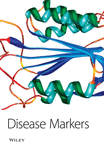Serum Ferritin Is Inversely Correlated with Serum Adiponectin Level: Population-Based Cross-Sectional Study
Abstract
Background: The serum concentrations of ferritin and adiponectin are associated with several metabolic disorders and have been used as predictors of insulin resistance and metabolic syndrome. But there have been no reports demonstrating a direct correlation between serum ferritin and adiponectin levels. We performed this study to evaluate the association between serum ferritin and adiponectin concentrations.
Subjects and methods: We evaluated a total of 995 subjects from the Korea Rural Genomic Cohort Study in a population-based cross-sectional study. Extensive clinical and laboratory measurements, including adiponectin and ferritin concentrations, were recorded.
Results: Univariate analysis revealed that the serum adiponectin level was correlated with age, sex, BMI, diastolic blood pressure, triglyceride, HDL-cholesterol, fasting blood glucose, fasting insulin, HOMA-IR, hs-CRP, and ferritin. Multivariate analysis demonstrated that the adiponectin concentration was correlated with age, BMI, fasting glucose, hs-CRP, and ferritin. The ferritin concentration was the most powerfully associated with serum adiponectin. In non-diabetic subgroups, the adiponectin level was correlated with BMI, triglyceride, HDL-cholesterol, fasting glucose, and ferritin level in multivariate analysis. In diabetic subgroups, the adiponectin level was correlated with BMI, triglyceride, hs-CRP, and ferritin level in multivariate analysis.
Conclusions: The serum adiponectin concentration was correlated with conventional clinical variables, but the most powerfully associated factor was the serum ferritin level.




